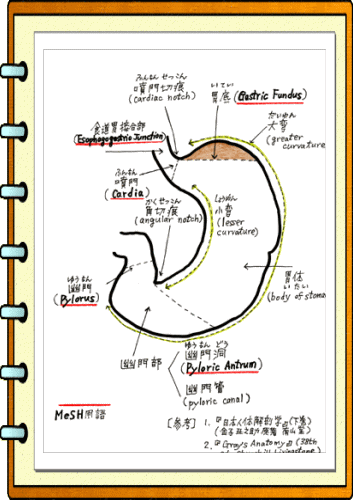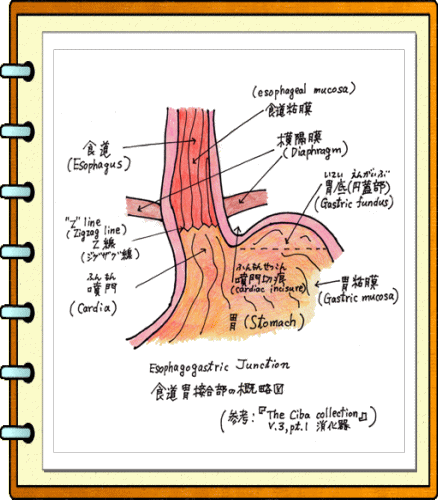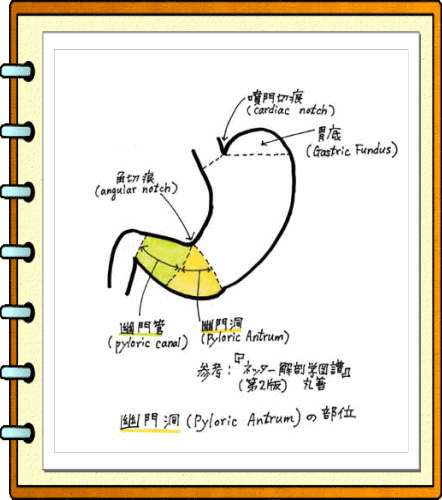
 消化器系の解剖学的MeSH用語
消化器系の解剖学的MeSH用語
| 目 次 (1)Digestive System(消化器系):消化器系の構成 (2)上部消化管と下部消化管 (3)小腸と大腸 (4)消化器系の流れ図 (5)胃の構造[1]:胃底の意味 (6)胃の構造[2]:MeSHでの胃の構成 (7)胆道系[1]:胆道系の構成 (8)胆道系[2]:肝内胆管と肝外胆管 (9)大腸と結腸 (10)膵 臓 (11)盲腸と虫垂 (12)オッディ括約筋とファーター乳頭 (13)メッケル憩室(Meckel Diverticulum) (14)口腔と肛門 (15)口腔の(Mouth)エントリー・ターム (16)膵管(Pancreatic ducts)は複数形 (17)下部食道括約筋(Esophageal Sphincter, Lower)と上部食道括約筋(Esophageal Sphincter, Upper) 巻末:参考図書 |
|||||
|
|
|||||
(1) 消化器系の構成 ♪現在、MeSHでは、消化器系はDigestive Systemの用語が使用されますが、1971年までは、Gastrointestinal System (1966-1971)の用語が使用されていました。 ♪スコープノートを見るとわかるように、消化器系は、管と、そのアクセサリー(付属物)と呼ばれる大きな腺とから構成されています。肝臓・膵臓などが、管のアクセサリーとなっているわけで、人体の神秘さのなかに優雅さを感じる表現です。 ♪Gastrointestinal Systemという用語では、胃(Gastro-)と腸(intestinal)だけを連想しますが、Digestive Systemとなると、肝臓や膵臓も含まれることになります。 Scope Note : A group of organs stretching from the MOUTH to the ANUS, serving to breakdown foods, assimilate nutrients, and eliminate waste. In humans, the disgestive system includes the GASTROINTESTINAL TRACT and the accessory glands (LIVER; BILIARY TRACT; PANCREAS). 口腔から肛門まで伸びている一連の器官で、食物を分解し、栄養物を消化吸収し、老廃物を排泄する機能をもつ。ひとでは、消化器系は、胃腸管系と、その付属消化器官である肝臓、胆道(胆道系)および膵臓を含んでいる。  Biliary Tract [A03.159] +(胆道系) Scope Note : The BILE DUCTS and the GALLBLADDER. 胆道系とは胆管と胆嚢をいう。 Gastrointestinal Tract [A03.556] +(胃腸管系) Scope Note : Generally refers to the digestive structures stretching from the MOUTH to ANUS, but does not include the accessory glandular organs ( LIVER; BILIARY TRACT; PANCREAS). 一般的に胃腸管系とは口腔から肛門まで伸びる消化器管腔構造をいい、それには、付属消化器官である肝臓、胆道系、膵臓は含まれない。 Liver [A03.620] +(肝臓) Pancreas [A03.734] +(膵臓) ♪膵臓のスコープノートは、2004年のものと、2007年とのものでは、その表現に、違いがみられます。 Scope Note :(2004) A mixed exocrine and endocrine gland situated transversely across the posterior abdominal wall in the epigastric and hypochondriac regions. The endocrine portion is comprised of the ISLETS OF LANGERHANS, while the exocrine portion is a compound acinar gland that secretes digestive enzymes. 膵臓は、外分泌腺でもあり内分泌腺でもある。上腹部、季肋下の後腹壁側に横たわる臓器である。内分泌腺の部分は、ランゲルハンス島からなっており、一方、外分泌腺の部分としては、消化酵素を分泌する合成腺房器官である。 Scope Note :(2007) A nodular organ in the ABDOMEN that contains a mixture of ENDOCRINE GLANDS and EXOCRINE GLANDS. The small endocrine portion consists of the ISLETS OF LANGERHANS secreting a number of hormones into the blood stream. The large exocrine portion (EXOCRINE PANCREAS) is a compound acinar gland that secretes several digestive enzymes into the pancreatic ductal system that empties into the DUODENUM. 膵臓は、腹部にある結節性臓器で、内分泌腺と外分泌腺の混合した臓器である。小さい内分泌腺の部分は、ランゲルハンス島からなっており、血流に、たくさんのホルモンを分泌する。外分泌腺の部分としては、いくつかの消化酵素を、膵管系に分泌する合成腺房器官で、十二指腸に排泄する。 (2)上部消化管と下部消化管 ♪消化管は、解剖学的に、上部(Upper)と下部(Lower)に区別されますが、MeSH DescriptorでGastrointestinal Tract(胃腸管系)を上部消化管(Upper Gastrointestinal Tract)と下部消化管(Lower Gastrointestinal Tract)に区別したのは、2004年のことでした。 ♪からだの方向を示す用語として、superior(上)とinferior(下)という用語もあります。この「上」は、「頭側」の意で、「下」は「尾側」の意味で使われます。(『人体解剖学』藤田恒太郎 南江堂) 上部消化管: Upper Gastrointestinal Tract [A03.556.875] +(上部消化管) Scope Note : The segment of GASTROINTESTINAL TRACT that includes the ESOPHAGUS; the STOMACH; and the DUODENUM. 上部消化管は、胃腸管系のうち、食道、胃および十二指腸の部分をいう。 Upper Gastrointestinal Tract [A03.556.875](上部消化管) Duodenum [A03.556.875.249] +(十二指腸) Esophagus [A03.556.875.500] +(食道) Stomach [A03.556.875.875] +(胃) ♪上部消化管(Upper Gastrointestinal Tract): 食道(Esophagus)→胃(Stomach)→十二指腸(Duodenum) 下部消化管: Lower Gastrointestinal Tract [A03.556.249] +(下部消化管) Scope Note : The segment of GASTROINTESTINAL TRACT that includes the small intestine below the DUODENUM, and the LARGE INTESTINE. 下部消化管とは、胃腸管系のうち、十二指腸より下の小腸および大腸をいう。 Lower Gastrointestinal Tract [A03.556.249](下部消化管) Ileum [A03.556.249.124] +(回腸) Intestine, Large [A03.556.249.249] +(大腸) Jejunum [A03.556.249.750](空腸) ♪下部消化管(Lower Gastrointestinal Tract) 空腸(Jejunum)→回腸(Ileum)→大腸(Intestine, Large) ♪解剖学の教科書では、下部消化管のスコープノートのなかにある小腸は、十二指腸と空腸・回腸に区分されますが、小腸のうち、一番、口側に近い、十二指腸は、上部消化管とされます。 (平成19年7月15日記) (3)小腸(Intestine, Small)と大腸(Intestine, Large) ♪小腸は、十二指腸・空腸・回腸の3部に区別され、大腸は、盲腸・結腸・直腸の3部に分けられます。 小 腸:十二指腸 → 空 腸 → 回 腸 大 腸:盲 腸 → 結 腸 → 直 腸 3.1 小 腸 Intestine, Small [A03.556.124.684] Scope Note : The portion of the GASTROINTESTINAL TRACT between the PYLORUS of the STOMACH and the ILEOCECAL VALVE of the LARGE INTESTINE. It is divisible into three portions: the DUODENUM, the JEJUNUM, and the ILEUM. 小腸は、胃の幽門と大腸の回盲弁との間の胃腸管の部分をいう。十二指腸、空腸および回腸の3つの部分に分けられる。 十二指腸 Duodenum [A03.556.124.684.124] +(十二指腸) Scope Note : The shortest and widest portion of the SMALL INTESTINE adjacent to the PYLORUS of the STOMACH. It is named for having the length equal to about the width of 12 fingers. 十二指腸は、小腸のなかで、最も短く、幅広い部分で、胃の幽門に隣接している。十二指腸という名前は、その長さが12本の指の幅位であることによる。 ♪十二指腸は、ツリー構造からわかるように、小腸の下位概念であるとともに、上部消化管の下位概念であります。 Intestine, Small [A03.556.124.684](小腸) Duodenum [A03.556.124.684.124] +(十二指腸) Ileum [A03.556.124.684.249] +(回腸) Jejunum [A03.556.124.684.500](空腸) Upper Gastrointestinal Tract [A03.556.875](上部消化管) Duodenum [A03.556.875.249] +(十二指腸) Esophagus [A03.556.875.500] +(食道) Stomach [A03.556.875.875] +(胃) Chained MeSH: ♪DuodenumのSee AlsoにDuodenoscopy(十二指腸内視鏡)があります。そのスコープノートを見ておきます。 Duodenoscopy Scope Note : Endoscopic examination, therapy or surgery of the luminal surface of the duodenum. 十二指腸内視鏡は、十二指腸の管腔表面の検査、治療および外科手術の目的で行われる。 空 腸 Jejunum [A03.556.124.684.500](空 腸) Scope Note : The middle portion of the SMALL INTESTINE, between DUODENUM and ILEUM. It represents about 2/5 of the remaining portion of the small intestine below duodenum. 空腸は、小腸の中間部分で、十二指腸と回腸と間をいう。十二指腸の下の小腸部分の約2/5に相当する。 回 腸 Ileum [A03.556.124.684.249] +(回 腸) Scope Note : The distal and narrowest portion of the SMALL INTESTINE, between the JEJUNUM and the ILEOCECAL VALVE of the LARGE INTESTINE. 回腸は、小腸のなかで、遠位(末端)にあり、最も狭い部分である。空腸と大腸(LARGE INTESTINE)の回盲弁との間をいう。 3.2 大 腸 Intestine, Large [A03.556.124.526](大腸) Anal Canal [A03.556.124.526.070](肛門管) Cecum [A03.556.124.526.209] +(盲腸) Colon [A03.556.124.526.356] +(結腸) Rectum [A03.556.124.526.767](直腸) ♪大腸の下位概念には、肛門管(Anal Canal)、盲腸(Cecum)、結腸(Colon)および直腸(Rectum)の4つの用語からなるが、大腸のスコープノートのなかでは、肛門管(Anal Canal)は、含まれていません。 大 腸 Intestine, Large [A03.556.124.526] Scope Note : A segment of the LOWER GASTROINTESTINAL TRACT that includes the CECUM; the COLON; and the RECTUM. 大腸は、下部消化管の一部で、盲腸、結腸および直腸からなる。 〔1〕Cecum [A03.556.124.526.209] +(盲腸) Scope Note : The blind sac or outpouching area of the LARGE INTESTINE that is below the entrance of the SMALL INTESTINE. It has a worm-like extension, the vermiform APPENDIX. 盲腸は、大腸の盲嚢であり、外に突き出した袋状の場所をいう。小腸の入口の下に位置している。みみずの虫のようにみえる附属物の虫垂(vermiform APPENDIX)を持っている。 〔2〕Colon [A03.556.124.526.356] +(結腸) Scope Note : The segment of LARGE INTESTINE between the CECUM and the RECTUM. It includes the ASCENDING COLON; the TRANSVERSE COLON; the DESCENDING COLON; and the SIGMOID COLON. 結腸は、大腸のうち盲腸と直腸との間をいう。上行結腸、横行結腸、下行結腸およびS状結腸からなる。 〔3〕Rectum [A03.556.124.526.767] +(直腸) Scope Note : The distal segment of the LARGE INTESTINE, between the SIGMOID COLON and the ANUS. 直腸は、大腸の遠位の部分で、S状結腸と肛門との間をいう。 〔4〕Anal Canal [A03.556.124.526.070](肛門管) Scope Note : The terminal segment of the LARGE INTESTINE, beginning from the ampulla of the RECTUM and ending at the anus. 肛門管は、大腸の終端部で、直腸膨大部からはじまり、肛門で終わる。 ♪2007年のMeSH Descriptor Data見ていて気がついたのですが、昨年まではなかった「Standard View. Go to Concept View; Go to Expanded Concept View」というリンクボタンができました。 ♪一つひとつのMeSH用語の概念が、いままでよりも、より整理された形で提供されており、このConcept Viewという考え方をみて、MeSH用語を通して、医学用語を学ぶことが、さらに、意味あることになったと感じます。 Chained:たまには「江戸東京」も覗いてみてください。 ♪「江戸東京」のなかで、デジタルアーカイブスのリンク集的なものを作成中ですが、古河歴史博物館のホームページに「日本の解剖ことはじめ 古河藩医 河口信任とその系譜」の電子展示があることに気づきました。 ♪そのなかで、古河藩医であった河口信任(かわぐち・しんにん)(1736-1811)が、明和9年(1772)に著した『解屍編(かいしへん)』(古河市指定文化財)の圖繪がデジタル化されています。 ♪「日本の解剖ことはじめ」の解説付きの図録も販売されており、23枚の圖繪を印刷物の形でもみることができます。「蔵府前面之圖」と「大小腸除脂之圖」という圖があって、そのなかで、大腸、小腸、大腸下口という用語が使われています。大変、美しく、わかりやすい貴重な刊行物です。 (平成19年9月1日 記) (4):消化器系の流れ図 口 腔(Mouth) ↓ ↓ 咽 頭(Pharynx) ↓ ↓ 食 道(Esophagus) ↓ ↓ 胃(Stomach) ↓ ↓ 十二指腸(Duodenum) ←←←←←←←← 胆道系(Biliary Tract)、膵臓(Pancreas)、肝臓(Liver)、 十二指腸: 胆道系: 膵 臓: 肝 臓: ↓ ↓ 空 腸(Jejunum) ↓ ↓ 回 腸(Ileum) ↓ ↓ 盲 腸(Cecum) + 虫 垂(Appendex) 盲 腸: 虫 垂: ↓ ↓ 結 腸(Colon) ↓ ↓ 直 腸(Rectum) ↓ ↓ 肛門管(Anal Canal) (平成19年9月30日 訂正 記) (5):胃の構造(1):胃底の違い ○ 胃の区分と名称には、解剖学的名称とX線学的名称とがある。また、『胃癌取扱い規約』(参考文献1)が採用する機械的区分もある。(参考文献2) 1)解剖学的名称 : 噴 門 胃 底 胃 体 幽門部 2)X線学的名称 : 噴門部 胃体部 胃底部 幽門部(胃前庭部) 3)機械的区分 :(『胃癌取扱い規約』の区分) 胃の大彎および小彎を3等分し、それぞれの対応点を結んで、胃をU(上部)、M(中部)およびL(下部)の3つの領域に分ける。 ○ 胃底 (Fundus)という用語は解剖学とX線診断学では、その部位が違う。胃底は、「胃内部に流動物がたまる膨らみ」であり、解剖学的にみると背臥位に置いた死体の胃で噴門の左側の膨らみが低位となるため、ここを胃底という。これに対してX線診断学では、かつて立位で検査していたため、造影剤のたまる尾極部を胃底という。 ○ MeSH用語でのGastric Fundus ( 胃底 )は、そのScope Noteで、次のように述べられている。 Scope Note : The superior portion of the body of the stomach above the level of the cardiac notch. 胃底とは、噴門切痕のレベルより上の胃体の上方の部分をいう。 ・・・・・・・・・・・・・・・・・・・・・・・・・・・・・・・・・・・・・・・・・・・・・・・・・・・・・・・・・・・・・・・・・・・・ (注) Cardiac notch :(噴門切痕): ♪「食道の下端が胃につづく部の左側は深い切痕をなし、これを噴門切痕」といいます。 ♪『解剖学用語』(改定13版 解剖学用語委員会編 医学書院 2007)によると、噴門切痕の英語の用語は、cardial notchとなっています。 ♪cardiacには、(心臓の)と(噴門の)の2つの意味がありますが、一般的に、cardiacは、心臓の形容詞形として用いられ、噴門の場合には、cardialが使われます。cardiac notch of left lungの場合のcardiac notchは左肺の前縁にある心切痕を意味します。 (平成20年1月19日 訂正改定) (参考文献) (1)『胃癌取扱い規約』(1999年6月[第13版])(日本胃癌学会編 金原出版 1999) (2)『消化器の局所解剖学 食道・胃』(佐藤達夫著 金原出版 1993)  (6):胃の構造(2):MeSHでの胃の構成 Stomach [A03.556.875.875](胃) Cardia [A03.556.875.875.163](噴門) Esophagogastric Junction [A03.556.875.875.330](食道胃接合部) Gastric Fundus [A03.556.875.875.419](胃底) Gastric Mucosa [A03.556.875.875.440] +(胃粘膜) Gastric Stump [A03.556.875.875.578](胃断端) Pyloric Antrum [A03.556.875.875.716](幽門洞) Pylorus [A03.556.875.875.799](幽門) 1. Stomach [A03.556.875.875](胃) (http://www.nlm.nih.gov/cgi/mesh/2004/MB_cgi?term=Stomach&field=entry) Scope Note : An organ of digestion situated in the left upper quadrant of the abdomen between the termination of the ESOPHAGUS and the beginning of the DUODENUM. 胃は、腹部の左上1/4分野に位置する、食道(ESOPHAGUS)の終端と十二指腸(DUODENUM)のはじまりまでの器官をいう。 1.1 Cardia [A03.556.875.875.163](噴門) (http://www.nlm.nih.gov/cgi/mesh/2004/MB_cgi?term=Cardia&field=entry) Scope Note : That part of the stomach surrounded by the esophagogastric junction, characterized by the lack of acid-forming cells. 食道胃接合部によって囲まれている胃の部分で、酸を産生する細胞の欠如が、その特徴である。 1.2 Esophagogastric Junction [A03.556.875.875.330](食道胃接合部) (http://www.nlm.nih.gov/cgi/mesh/2004/MB_cgi?term=Esophagogastric+Junction&field=entry) Esophagogastric Junction [A03.556.875.875.330](食道胃接合部)という用語は、『食道癌取扱い規約』でも使用される。  1.3 Gastric Fundus [A03.556.875.875.419](胃底) (http://www.nlm.nih.gov/cgi/mesh/2004/MB_cgi?term=Gastric+Fundus&field=entry) Scope Note : The superior portion of the body of the stomach above the level of the cardiac notch. 胃底とは、噴門切痕のレベルより上の胃体の上方の部分をいう。 1.4 Gastric Mucosa [A03.556.875.875.440] + (http://www.nlm.nih.gov/cgi/mesh/2004/MB_cgi?term=Gastric+Mucosa&field=entry) Scope Note : Surface epithelium in the stomach that invaginates into the lamina propria, forming gastric pits. Tubular glands, characteristic of each region of the stomach (cardiac, gastric, and pyloric), empty into the gastric pits. The gastric mucosa is made up of several different kinds of cells. 胃粘膜は、胃のなかにある表面上皮で、粘膜筋層(固有層)に陥入し、その表面に穴(胃小窩)(gastric pits)を開いている。 管状腺が胃小窩の粘膜固有層内に分布しており、噴門腺(cardiac)、胃底腺 (gastric)、幽門腺(pyloric)に区別され、それぞれの特徴をもつ。 胃粘膜は、いくつかの異なった種類の細胞からできている。 (参考ホームページ):エーザイ:胃のサイエンス (http://www.eisai.co.jp/stomach/kenkou/04.html) 1.5 Gastric Stump [A03.556.875.875.578](胃断端) (http://www.nlm.nih.gov/cgi/mesh/2004/MB_cgi?term=Gastric+Stump&field=entry) Scope Note : That portion of the stomach remaining after gastric surgery, usually gastrectomy or gastroenterostomy for cancer of the stomach or peptic ulcer. It is a common site of cancer referred to as stump cancer or carcinoma of the gastric stump. 胃手術後に残った胃の部分である。通常、胃断端は、胃癌あるいは消化性潰瘍に行われる胃切除術(gastrectomy)あるいは胃腸吻合術(gastroenterostomy)にともなって残る胃の部分をいう。そこは、癌が遺存している部位ともなり、断端癌に関係している。 1.6 Pyloric Antrum [A03.556.875.875.716](幽門洞) (http://www.nlm.nih.gov/cgi/mesh/2004/MB_cgi?term=Pyloric+Antrum&field=entry) 幽門部は、胃体と幽門との間にある部分をいう。幽門洞および幽門管に区別され、幽門洞は吻側部にあってやや拡がっており、幽門管は尾側部で管状をなしている。 幽門洞と幽門管との境が、中間溝である。  1.7 Pylorus [A03.556.875.875.799](幽門) (http://www.nlm.nih.gov/cgi/mesh/2004/MB_cgi?term=Pylorus&field=entry) 幽門は、胃の十二指腸への開口部である。 (7):胆道系(1):胆道系の構成 Biliary Tract [A03.159](胆道系) (http://www.nlm.nih.gov/cgi/mesh/2004/MB_cgi?term=Biliary+Tract&field=entry) Scope Note : The BILE DUCTS and the GALLBLADDER. 胆道系(Biliary Tract)とは、 胆管 (BILE DUCTS)と胆嚢 (GALLBLADDER)をいう。 Bile Ducts [A03.159.183] +(胆管) (http://www.nlm.nih.gov/cgi/mesh/2004/MB_cgi?term=Bile+Ducts&field=entry) Scope Note : The channels that collect and transport the bile secretion from the BILE CANALICULI, the smallest branch of the BILIARY TRACT in the LIVER, through the bile ductules, the bile ducts out the liver, and to the GALLBLADDER for storage. 肝臓のなかにある胆道系(BILIARY TRACT)の最も細い枝である胆細管(BILE CANALICULI)から、胆細管(肝内胆管)、肝外胆管を通して、胆嚢(GALLBLADDER)(胆汁の貯蔵)まで胆汁を集めて運搬するための通路である。 胆細管 | ↓ 肝 臓 | ↓ 総肝管 | ↓ 胆 嚢 ―→ 胆嚢管 ―→ 総胆管 ←― 膵 管 ←― 膵 臓 | | ↓ 十二指腸 ←― 副膵管 ←― 膵 臓 ( 学 習 :流れ図のなかの解剖学用語を、MeSH用語ではなんというか考えてみましょう) Gallbladder [A03.159.439](胆嚢) (http://www.nlm.nih.gov/cgi/mesh/2004/MB_cgi?term=Gallbladder&field=entry) Scope Note : A storage reservoir for BILE secretion. Gallbladder allows the delivery of bile acids at a high concentration and in a controlled manner, via the CYSTIC DUCT to the DUODENUM, for degradation of dietary lipid. 胆嚢は、胆汁(BILE)の貯留器である。 胆汁酸は胆嚢で統制された方法で濃縮され胆嚢管(CYSTIC DUCT)を通って、食物由来の脂質を可溶化するするために、十二指腸(DUODENUM)に放出される。  (8)胆道系(2):肝内胆管と肝外胆管 胆管(Bile Ducts)は、肝内胆管と肝外胆管に区別される。肝管合流部を基準として肝内胆管、肝外胆管ともいうが、一般には、総胆管と総肝管とをまとめて肝外胆管という。肝内肝管の二次分枝まで管腔構造として抽出できる。 また、『胆道癌取扱い規約』では、肝外胆管を3区域(上部胆管・中部胆管・下部胆管)に区別している。 (1) Bile Ducts, Intrahepatic [A03.159.183.158] +(肝内胆管) (http://www.nlm.nih.gov/cgi/mesh/2004/MB_cgi?term=Bile+Ducts,+Intrahepatic&field=entry) Scope Note : Passages within the liver for the conveyance of bile. Includes right and left hepatic ducts even though these may join outside the liver to form the common hepatic duct. 肝内胆管とは、肝臓内で胆汁の運搬を行う通路をいう。肝臓の外で総肝管となる右肝管と左肝管を含める。 1.1 Bile Canaliculi [A03.159.183.158.125](小胆管) (http://www.nlm.nih.gov/cgi/mesh/2004/MB_cgi?term=Bile+Canaliculi&field=entry) Scope Note : Minute intercellular channels that occur between liver cells and carry bile towards interlobar bile ducts. Also called bile capillaries 小胆管(Bile Canaliculi)とは、肝細胞の間にある微細な細胞間胆汁路をいう。小葉間胆管に向かって胆汁を運ぶ。 毛細胆管(bile capillaries)とも呼ばれる。 (2) Bile Ducts, Extrahepatic [A03.159.183.079] +(肝外胆管) (http://www.nlm.nih.gov/cgi/mesh/2004/MB_cgi?term=Bile+Ducts,+Extrahepatic&field=entry) Scope Note : Passages external to the liver for the conveyance of bile. These include the COMMON BILE DUCT and the common hepatic duct (HEPATIC DUCT, COMMON). 肝外胆管(Bile Ducts, Extrahepatic)とは、胆汁の運搬のための肝臓の外についた管(注)をいう。 総胆管(COMMON BILE DUCT)と総肝管(HEPATIC DUCT, COMMON))からなる。 ●(注)肝門(Porta hepatis)の外の導管をいいますが、MeSHでは、肝門を出た右肝管と左肝管を肝内胆管としています。 2.1 Common Bile Duct [A03.159.183.079.300] +(総胆管) (http://www.nlm.nih.gov/cgi/mesh/2004/MB_cgi?term=Common+Bile+Duct&field=entry) Scope Note : The largest bile duct. It is formed by the junction of the CYSTIC DUCT and the COMMON HEPATIC DUCT. 総胆管(Common Bile Duct)は、最も大きな胆管である。胆嚢管と総肝管とが結合して総胆管となる。 2.2 Cystic Duct [A03.159.183.079.450](胆嚢管) (http://www.nlm.nih.gov/cgi/mesh/2004/MB_cgi?term=Cystic+Duct&field=entry) Scope Note : The duct that is connected to the GALLBLADDER and allows the emptying of bile into the COMMON BILE DUCT. 胆嚢管(Cystic Duct)は、胆嚢と結ばれている管であり、総胆管に胆汁を注ぐ。 2.3 Hepatic Duct, Common [A03.159.183.079.600](総肝管) (http://www.nlm.nih.gov/cgi/mesh/2004/MB_cgi?term=Hepatic+Duct,+Common&field=entry) Scope Note : Predominantly extrahepatic bile duct which is formed by the junction of the right and left hepatic ducts, which are predominantly intrahepatic, and, in turn, joins the cystic duct to form the common bile duct. 総肝管(Hepatic Duct, Common)(注)は、主に肝臓内にある胆管である右肝管と左肝管とが合流することによって形成される肝臓の外の胆管をいい、胆嚢管と合流して総胆管となる。 ●(注)commonをつけず、単にhepatic ductとしても総肝管のことを指します。  (9)大腸と結腸 ●大腸は、回腸の末端から肛門までの約1.5メートルの消化管で、盲腸、結腸、直腸の3部に区分されます。MeSHでは、盲腸の下位概念に虫垂があり、直腸に続く肛門(管)は、直腸の下位概念となっています。 ●結腸は、上行結腸、横行結腸、下行結腸、S状結腸の4部に区分されます。 ●結腸は、大腸の下位概念となっています。 [大 腸] Intestine, Large [A03.556.124.526](大腸) Cecum [A03.556.124.526.209] +(盲腸) Colon [A03.556.124.526.356] +(結腸) Rectum [A03.556.124.526.767] +(直腸) 1. Intestine, Large(大腸) (http://www.nlm.nih.gov/cgi/mesh/2004/MB_cgi?term=Intestine,+Large&field=entry) Scope Note : A segment of the LOWER GASTROINTESTINAL TRACT that includes the CECUM; the COLON; and the RECTUM. 大腸は、下部消化管(LOWER GASTROINTESTINALTRACT)の一部で、盲腸(CECUM)、結腸(COLON)および直腸(RECTUM)からなる。 1.1 Cecum(盲腸) (http://www.nlm.nih.gov/cgi/mesh/2004/MB_cgi?term=Cecum&field=entry) Scope Note : The blind sac or outpouching area of the LARGE INTESTINE that is below the entrance of the SMALL INTESTINE. It has a worm-like extension, the vermiform APPENDIX. 盲腸は、大腸(LARGE INTESTINE)の盲嚢であり、外に突き出した袋状の場所をいう。小腸(SMALL INTESTINE)の入口の下に位置している。みみずの虫のようにみえる附属物の虫垂(vermiform APPENDIX)を持っている。 1.2 Colon(結腸) (http://www.nlm.nih.gov/cgi/mesh/2004/MB_cgi?term=Colon&field=entry) Scope Note: The segment of LARGE INTESTINE between the CECUM and the RECTUM. It includes the ASCENDING COLON; the TRANSVERSE COLON; the DESCENDING COLON; and the SIGMOID COLON. 結腸は、大腸(LARGE INTESTINE)のうち盲腸(CECUM)と直腸(RECTUM)との間をいう。上行結腸(ASCENDING COLON)、横行結腸(TRANSVERSE COLON)、下行結腸(DESCENDING COLON)およびS状結腸(SIGMOID COLON)からなる。 1.3 Rectum(直腸) (http://www.nlm.nih.gov/cgi/mesh/2004/MB_cgi?term=Rectum&field=entry) Scope Note: The distal segment of the LARGE INTESTINE, between the SIGMOID COLON and the ANUS. 直腸は、大腸(LARGE INTESTIN)の遠位の部分で、S状結腸(SIGMOID COLON)と肛門(ANUS)との間をいう。 [結 腸] Colon [A03.556.124.526.356](結腸) Colon, Ascending [A03.556.124.526.356.333](上行結腸) Colon, Descending [A03.556.124.526.356.500](下行結腸) Colon, Sigmoid [A03.556.124.526.356.668](S状結腸) Colon, Transverse [A03.556.124.526.356.834](横行結腸) 2. Colon(結腸) (http://www.nlm.nih.gov/cgi/mesh/2004/MB_cgi?term=Colon&field=entry) Scope Note: The segment of LARGE INTESTINE between the CECUM and the RECTUM. It includes the ASCENDING COLON; the TRANSVERSE COLON;the DESCENDING COLON; and the SIGMOID COLON. 結腸は、大腸(LARGE INTESTINE)のうち盲腸(CECUM)と直腸(RECTUM)との間をいう。上行結腸(ASCENDING COLON)、横行結腸(TRANSVERSE COLON)、下行結腸(DESCENDING COLON)およびS状結腸(SIGMOID COLON)からなる。 2.1 Colon, Ascending(上行結腸) (http://www.nlm.nih.gov/cgi/mesh/2004/MB_cgi?term=Colon,+Ascending&field=entry) Scope Note: The segment of LARGE INTESTINE between the CECUM and the TRANSVERSE COLON. It passes cephalad from the cecum to the caudal surface of the right lobe of the LIVER where it bends sharply to the left, forming the right colic flexure. 上行結腸とは、大腸(LARGE INTESTINE)のうち盲腸(CECUM)と横行結腸(TRANSVERSE COLON)の間の部分をいう。盲腸から肝臓右葉の下面に頭側に向かう。 2.2 Colon, Descending(下行結腸) (http://www.nlm.nih.gov/cgi/mesh/2004/MB_cgi?term=Colon,+Descending&field=entry) Scope Note: The segment of LARGE INTESTINE between TRANSVERSE COLON and the SIGMOID COLON. 下行結腸とは、大腸(LARGE INTESTINE)のうち横行結腸(TRANSVERSE COLON)とS状結腸(SIGMOID COLON)との間の部分をいう。 2.3 Colon, Sigmoid(S状結腸) (http://www.nlm.nih.gov/cgi/mesh/2004/MB_cgi?term=Colon,+Sigmoid&field=entry) Scope Note: A segment of the COLON between the RECTUM and the descending colon. S状結腸とは、結腸のうち直腸と下行結腸の間の部分をいう。 2.4 Colon, Transverse(横行結腸) (http://www.nlm.nih.gov/cgi/mesh/2004/MB_cgi?term=Colon,+Transverse&field=entry) Scope Note: The segment of LARGE INTESTINE between ASCENDING COLON and DESCENDING COLON. It passes from the RIGHT COLIC FLEXURE across the ABDOMEN, then turns sharply at the LEFT COLIC FLEXURE into the descending colon. 横行結腸とは、大腸(LARGE INTESTINE)のうち上行結腸(ASCENDING COLON)と下行結腸(DESCENDING COLON)との間の部分をいう。右結腸曲(RIGHT COLIC FLEXURE)から腹部を横切って進み、左結腸曲(LEFT COLIC FLEXURE)で鋭角に屈曲して、下行結腸へと達する。 (10)膵 臓 Pancreas Islets of Langerhans Pancreatic Ducts 1.Pancreas(膵臓) (http://www.nlm.nih.gov/cgi/mesh/2004/MB_cgi?term=Pancreas&field=entry) Scope Note : A mixed exocrine and endocrine gland situated transversely across the posterior abdominal wall in the epigastric and hypochondriac regions. The endocrine portion is comprised of the ISLETS OF LANGERHANS, while the exocrine portion is a compound acinar gland that secretes digestive enzymes. 膵臓は、外分泌腺でもあり内分泌腺でもある。上腹部、季肋下の後腹壁側に横たわる臓器である。 内分泌腺の部分は、ランゲルハンス島(ISLETS OF LANGERHANS)からなっており、一方、外分泌腺の部分としては、 消化酵素を分泌する合成腺房器官である。 (注 記) ○膵臓は、長い不規則なプリズム形で、膵頭(neck)、膵体(body)、膵尾(tail)からなる。 ○膵臓は、外分泌腺と内分泌腺の両方を行う腺である。内分泌腺としては、インスリンをランゲルハンス島から分泌して 血中に出し糖代謝を調節し、外分泌腺としては、膵液を膵管によって十二指腸に運んで、蛋白、炭水化物、脂肪の 消化を助ける。 ●膵臓(Pancreas)のMeSH用語は、消化器系(Digestive System [A03])(A03.734)であるとともに、 内分泌腺(Exocrine Glands [A10.336])(A10.336.583)の用語でもあります。 1.1 Islets of Langerhans [A03.734.414](ランゲルハンス島) (http://www.nlm.nih.gov/cgi/mesh/2004/MB_cgi?term=Islets+of+Langerhans&field=entry) Scope Note : Irregular microscopic structures, varying from a few to hundreds of cells, scattered throughout the PANCREAS and comprising its endocrine portion. There are three cell types: alpha, secreting glucagon; beta, secreting insulin; and delta ( D CELLS), secreting somatostatin. ランゲルハンス島は、不規則な顕微鏡的構造で、数個から数百の細胞までいろいろあり、膵臓(PANCREAS)の 全体に散在する。膵臓の内分泌的部分を構成する。alph細胞(グルカゴン分泌)、beta細胞(インスリン分泌)、 delta細胞( D CELLS)(ソマトスタチン分泌)の3種類の細胞に区別される。 (注 記) ○ランゲルハンス島(Islets of Langerhans)は、Island of Langerhans(Islets of Langerhans 91; was ISLANDS OF LANGERHANS 1963-90)とも呼ばれ、内分泌腺細胞島である。 ●ランゲルハンスとは、ドイツの病理・解剖学者のPaul Langerhansのことで、幕末の1847年(弘化4)7月25日 ベルリンに生まれ、1888年(明治21)7月20日アフリカ北西部モロッコ(カサブランカ)沖に浮かぶマデイラ諸島 (ポルトガル領)のフンシャール(Funchal)で死んでいます。(参 照:人名がついたMeSH用語をさぐる) 1.2 Pancreatic Ducts[A03.734.667](膵管) (http://www.nlm.nih.gov/cgi/mesh/2004/MB_cgi?term=Pancreatic+Ducts&field=entry) Scope Note : Ducts that collect PANCREATIC JUICE from the PANCREAS and supply it to the DUODENUM. 膵管とは、膵臓から膵液(PANCREATIC JUICE)を集め十二指腸(DUODENUM.)に膵液を運ぶ導管である。 (注 記) ●膵管(pancreatic duct)と副膵管(accessory pancreatic duct) 膵臓は後部と前部の2部にわかれて発達し、後部の導管は独立して十二指腸に開口します。これを副膵管といいます。 これに対して、前部の導管は総胆管と合流して十二指腸に開口します。 (11)盲腸と虫垂 盲 腸(cecum) (http://www.nlm.nih.gov/cgi/mesh/2004/MB_cgi?term=Cecum&field=entry) Scope Note : The blind sac or outpouching area of the LARGE INTESTINE that is below the entrance of the SMALL INTESTINE. It has a worm-like extension, the vermiform APPENDIX. 盲腸とは、大腸(LARGE INTESTINE)の盲嚢であり、外に突き出した袋状の場所をいう。小腸(SMALL INTESTINE)の 入口の下に位置している。みみずの虫のようにみえる附属物の虫垂(vermiform APPENDIX)を持っている。 (注 記) 盲腸は、大腸の起始部で、回盲弁の下方に延びる大きな盲嚢部である。(『グレイ解剖学』) 虫 垂(Appendix) (http://www.nlm.nih.gov/cgi/mesh/2004/MB_cgi?term=Appendix&field=entry) Scope Note : A worm-like blind tube extension from the CECUM. 虫垂とは、盲腸からから出ている虫形の盲管をいう。 (注 記) ○虫垂は、正式にはappendix vermiformisという。MeSHでは、Vermiform Appendixが、エントリー・タームとなっている。 (12)オッデイ括約筋とファーター乳頭 「十二指腸(duodenum)下行部の後内側壁には、縦走する1本の粘膜ヒダがあり、これを十二指腸縦ヒダという。 その下端に大十二指腸乳頭(greater duodenal papilla)(ファーター乳頭 Vaterユs papilla)が隆起し、ここに総胆管 および膵管が共同に開く。ここをオッディ括約筋(Oddiユs sphincter)が取り囲んでいる。」(『日本人体解剖学』南山堂) 1.オッディ括約筋(Sphincter of Oddi) (http://www.nlm.nih.gov/cgi/mesh/2004/MB_cgi?term=Sphincter+of+Oddi&field=entry) Scope Note : The sphincter of the hepatopancreatic ampulla within the duodenal papilla. The COMMON BILE DUCT and main pancreatic duct pass through this sphincter. オッディ括約筋とは、十二指腸乳頭の内部にある胆膵管膨大部の括約筋をいう。総胆管と主膵管が、この括約筋を 通っている。 (注 記) ○Ruggero Oddi : イタリアの19世紀の解剖学者。(『グレイ解剖学』) (http://www.ncbi.nlm.nih.gov:80/entrez/query.fcgi?cmd=Retrieve&db=PubMed&list_uids=8185478&dopt=Abstract&itool=iconabstr) ●Sphincter of OddiのMeSH用語は、2004年に採用された用語で、2003年までは、Oddi's Sphicterの用語で索引されていました。 Replaced MeSH :(http://www.nlm.nih.gov/mesh/prefterm_change2004.html) 2.ファーター乳頭(Ampulla of Vater) (http://www.nlm.nih.gov/cgi/mesh/2004/MB_cgi?term=Ampulla+of+Vater&field=entry) Scope Note : A dilation of the duodenal papilla that is the opening of the juncture of the COMMON BILE DUCT and the MAIN PANCREATIC DUCT, also known as the hepatopancreatic ampulla. ファーター乳頭とは、十二指腸乳頭の膨大部で、そこに総胆管(COMMON BILE DUCT)と 主膵管(MAIN PANCREATIC DUCT)が合流して開口している。胆膵管膨大部(hepatopancreatic ampulla)ともいわれる。 (注 記) ○Abraham Vater (1684-1751): ドイツの解剖学・植物学者で、ウイッテンベルグ大学教授。(『グレイ解剖学』) (http://www.ncbi.nlm.nih.gov:80/entrez/query.fcgi?cmd=Retrieve&db=PubMed&list_uids=10691372&dopt=Abstract) ●Ampulla of VaterのMeSH用語は、2004年に採用された用語で、2003年までは、Vater's Ampullaで索引されていました。 Replaced MeSH : (http://www.nlm.nih.gov/mesh/prefterm_change2004.html) ●ファーター乳頭(Ampulla of Vater):「Ampulla」は、語訳的には、「膨大部」ですが、 ここでは、「Papilla」(Vater's papilla)の意味で、ファーター乳頭としました。 (13)メッケル憩室(Meckel Diverticulum) (http://www.nlm.nih.gov/cgi/mesh/2004/MB_cgi?term=Meckel+Diverticulum&field=entry) 「回腸が盲腸に開く部から約50ム80cm上方の回腸壁において、腸間膜付着部の反対側に、円錐形または円柱状の 突出物をみることがある。これをメッケル憩室といい、胎生期における卵黄腸管(vitteline duct)の遺残物である。」 (『日本人体解剖学』南山堂) Scope Note : A congenital abnormality characterized by the outpouching or sac formation in the ILEUM. It is a remnant of the embryonic YOLK SAC in which the VITELLINE DUCT failed to close. メッケル憩室とは、回腸の突出物あるいは嚢形成に特徴のある先天異常である。胎生期の卵黄嚢の残渣で卵黄腸管が 遺残(未閉鎖)している。 (注 記) ○ Johann Friedrich Meckel(1781-1833)ドイツの解剖・外科学者で、ハレ大学教授。(『グレイ解剖学』) (http://www.whonamedit.com/doctor.cfm/1840.html) ○Meckel DiverticulumのMeSH用語は、2004年に採用された用語で、2003年までは、Meckel's Diverticulumで索引されていた。 Replaced MeSH: (http://www.nlm.nih.gov/mesh/prefterm_change2004.html) (14)口腔と肛門 1.口腔(Mouth) (http://www.nlm.nih.gov/cgi/mesh/2004/MB_cgi?term=Mouth&field=entry) Scope Note : The oval-shaped oral cavity located at the apex of the digestive tract and consisting of two parts: the vestibule and the oral cavity proper. 卵の形をした口腔は、消化管のはじまりに位置しており、2つの部分に区別される。 すなわち口腔前庭(vestibule)と固有口腔(oral cavity proper)である。 (注 記) ○ 口腔(Mouth)(Cavity of the mouth)(Oral cavity) は消化管のはじまり。外側の、より狭い部分を口腔前庭 (Vestibule)といい、内側のより広い部分を固有口腔(Mouth cavity proper)という。(『グレイ解剖学』) ○ 口腔前庭:これは上下の歯列と歯槽部の外側を取りまくU字形の狭い空間である。 (『人体解剖学』藤田恒太郎著 南江堂) ○ 固有口腔:上壁は口蓋で、これによって鼻腔から境され、下壁は口底で、舌が、その大部分を占める。 (『人体解剖学』藤田恒太郎著 南江堂) 2.肛門(Anus) (http://www.nlm.nih.gov/cgi/mesh/2004/MB_cgi?term=Anus&field=entry) Scope Note : The terminal segment of the LARGE INTESTINE, begining from the ampulla of the RECTUM and ending at the opening. 肛門とは、大腸(LARGE INTESTINE)の終末部であり、直腸(RECTUM)の括約筋にはじまり、開口して終る。 (注 記) ○ 肛門管(Anal canal)、すなわち大腸の終末部は前立腺尖の高さで始まり、肛門に終る。(『グレイ解剖学』) (15)口腔の(Mouth)エントリー・ターム (http://www.nlm.nih.gov/cgi/mesh/2004/MB_cgi?term=Mouth&field=entry) ○ 一般的には、口腔というと、Oral Cavityが浮かびますが、MeSH用語では、口腔にはMouthという用語が使われてます。 ○ 解剖学名には、ラテン語名、英語名、日本語名など、いろいろあり、また、英語名でも、口腔の形容詞形として、 Oralが使われたり、Mouthが使われたりと、さまざまです。 ○ どの解剖学用語がMeSHのディスクリプター(統制語)として採用されているかを理解しておくことが必要ですが、 MeSHには、エントリー・ターム(Entry Term)が用意されていて、適切な統制語に導く手助けとなっています。 ○「医学用語を歩く」的に考えると、まず、口腔のMeSH用語をMouthと覚えて、それから、横断参照的に エントリー・タームを学習していくと、口腔の理解がさらに深まることになります。 Entry Term Oral Cavity(口腔) Entry Term Cavitas Oris(口腔) Entry Term Cavitas oris propria(固有口腔) Entry Term Mouth Cavity Proper(固有口腔) Entry Term Oral Cavity Proper(固有口腔) Entry Term Vestibule Oris(口腔前庭) Entry Term Vestibule of the Mouth(口腔前庭) ○ 口腔前庭と固有口腔は、口腔の下位概念に位置付けられていうように思いますが、MeSHでは、エントリー・タームと なっており、関連用語として学習することが重要になります。 (16)膵管(Pancreatic ducts)は複数形 (http://www.nlm.nih.gov/cgi/mesh/2004/MB_cgi?term=Pancreatic+Ducts&field=entry) ○膵管というと、単数形のPancreatic ductを思い浮かべ、主膵管(Main pancreatic duct)のことと考えるが、 MeSHでは、膵管を複数形のPancreatic ductsとして、主膵管(Main pancreatic duct : duct of Wirsung : Pancreatic duct)と副膵管(Accessory pancreatic duct :duct of Santorini)のことを指す。 ○ Pancreatic ducts(膵管)のエントリー・ターム Entry Term Duct of Santorini(サントリーニ管)[副膵管] Entry Term Duct of Wirsung(ウィルズング管)[主膵管] Entry Term Duodenal Papilla, Minor(小十二指腸乳頭) Entry Term Wirsung's Duct(ウィルズング管)[主膵管] Entry Term Accessory Pancreatic Duct(副膵管) Entry Term Main Pancreatic Duct(主膵管) Entry Term Santorini's Duct(サントリーニ管)[副膵管] (参 考) サントリーニ:Giovanni Domenico Santorini(1681-1737):イタリアの解剖学者で、ベネチア大学教授。(『グレイ解剖学』) ウィルズング:Johann Georg Wirsung(1600-1643):ドイツの解剖学者。(グレイ解剖学) ○主膵管(Main pancreatic duct)は、ファーター乳頭(Ampulla of Vater)[大十二指腸乳頭(DUODENAL PAPILLA, MAJOR)](注記)で総胆管と合流して十二指腸に開口し、副膵管(Accessory Pancreatic Duct)は、独立して 小十二指腸乳頭(DUODENAL PAPILLA, MINOR)で十二指腸に開口する。 (注記)大十二指腸乳頭を、単に十二指腸乳頭(duodenal papilla)という場合もある。 (17)下部食道括約筋(Esophageal Sphincter, Lower)と上部食道括約筋(Esophageal Sphincter, Upper) Esophagus [A03.556.875.500](食道) Esophageal Sphincter, Upper [A03.556.875.500.360] (上部食道括約筋) Esophagogastric Junction [A03.556.875.500.414] (食道胃接合部) Esophageal Sphincter, Lower [A03.556.875.500.414.350] (下部食道括約筋) Chained MeSH:Esophagogastric Junction(食道胃接合部)→→(6):胃の構造(2):MeSHでの胃の構成 Esophageal Sphincter, Lower(下部食道括約筋)(2005 New Descriptor) (http://www.nlm.nih.gov/cgi/mesh/2005/MB_cgi?mode=&term=Esophageal+Sphincter,+Lower&field=entry) Scope Note: The physiologic or functional barrier to GASTROESOPHAGEAL REFLUX at the esophagogastric junction. Sphincteric muscles remain tonically contracted during the resting state and form the high-pressure zone separating the lumen of the ESOPHAGUS from that of the STOMACH. (Haubrich et al, Bockus Gastroenterology, 5th ed., pp399, 415) 胃食道逆流症(GASTROESOPHAGEAL REFLUX)を防ぐためにある生理学的および機能的な障壁をいう。括約筋は、休息の状態でも、緊張して引き締められている。食道内腔と胃内腔を分ける昇圧帯を形成している。 Esophageal Sphincter, Upper(上部食道括約筋)(2005 New Descriptor) (http://www.nlm.nih.gov/cgi/mesh/2005/MB_cgi?mode=&term=Esophageal+Sphincter,+Upper&field=entry) Scope Note: The structure at the pharyngoesophageal junction consisting chiefly of the cricopharyngeus muscle. It normally occludes the lumen of the ESOPHAGUS, except during SWALLOWING. 上部食道括約筋は、おもに輪状咽頭筋からなる咽頭食道接合部の構造である。それによって、嚥下のときを除いて、普通は、食道の内腔を閉鎖している。 参考図書 ●『Medical Subject Headings』には、各カテゴリーに参考文献(Bibliography)があります。 (http://www.nlm.nih.gov/mesh/biblio2004.html) ●「Category A」では、『Clemente, C.D., ed. Gray's anatomy. 30th American ed. Philadelphia: Lea & Febiger, 1985.』があげられています。この『Gray's anatomy』の30版は、最新版ではありません。最新版には、CDが付属していますが、本体が大判で扱いにくいのが欠点です。 ●『Gray's anatomy』の29版には、訳本『グレイ解剖学』があります。元日本医学図書館協会会長の嶋井和世先生が監訳されています。 『Gray's anatomy』のほかに、今回、参考にしたもののなかから、日本語の解剖学の教科書を紹介しておきます。 ●『日本人体解剖学』(金子丑之助原著 南山堂)は、本文の見出しや図のタカリの解剖学用語が日本語と英語で併記されており、また、巻末のIndexは、解剖学名の日本語名、よみ、英語名、ラテン語名の一覧表の形式になっています。解剖学の日本語名は、読み方がわからないことがあるので、大変便利な索引です。 ●『日本人体解剖学』は上下2巻で、高価なのが難ですが、古本ででも入手しておきたい図書です。 ●これに対して、藤田恒太郎著の『人体解剖学』(南江堂)は、初学者のための教科書として総論に重点を置いた書き方で読みやすく、一冊にまとめられているのも重宝です。巻頭の緒論の項では、「からだの方向用語」として、矢状(しじょう)(sagittal)、内(internal)、前(anterior)、上(superior)などの解剖学の基本用語も解説されていて、できれば購入しておきたい一冊です。 ●『ネッター解剖学図譜』(丸善)は、『TheCIBA collection of Medical Illustrations』と知られる図譜集のなかから、とくに人体構造に関わるものを集めたものです。解剖学用語は、日本語と英語で併記されており、日本語用語は、日本解剖学会編『解剖学用語』(改訂12版 丸善)を底本にしており、是非、座右に置きたい一冊です。 |
|||||